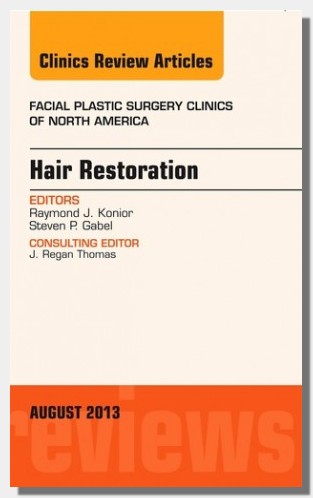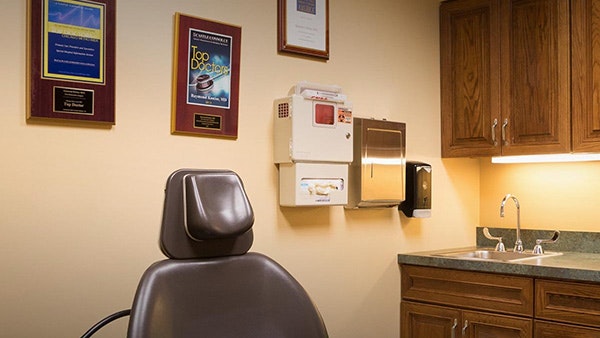Chicago Sun-Times, Hair Restoration, Dr. Ray Konior
Hair Restoration
Raymond Konior, M.D.
 The elusive goal of restoring a perfectly natural, completely undetectable hairline via surgical means is possible today more so than ever before. "The means by which a surgeon can create an undetectable hairline revolves around the production of a follicular-unit graft." Unlike the large unsightly plugs produced by outdated methods, follicular-unit grafts are created using high power magnification."State of the art surgical teams use ultra-refined techniques to meticulously dissect individual follicular-units which are then implanted seamlessly into the balding regions of the scalp."
The elusive goal of restoring a perfectly natural, completely undetectable hairline via surgical means is possible today more so than ever before. "The means by which a surgeon can create an undetectable hairline revolves around the production of a follicular-unit graft." Unlike the large unsightly plugs produced by outdated methods, follicular-unit grafts are created using high power magnification."State of the art surgical teams use ultra-refined techniques to meticulously dissect individual follicular-units which are then implanted seamlessly into the balding regions of the scalp."
Ultra-refined methods require a dedicated team to use high power magnification and absolute precision during all phases of the restoration procedure - graft dissection, recipient site preparation and graft insertion. "Performing any of these critical phases without magnification will compromise the final result in terms of its naturalness and undetectability." Unfortunately, ultra-refined methods are still performed by a relatively small percentage of hair restoration practices.
Although today's techniques produce a natural, undetectable result when properly implemented, patients and surgeons alike still have to deal with the chief limiting factor associated with hair transplantation - that being the density one can obtain in the restoration zone. "The number of hairs one can donate to his or her" own cause is limited based on the availability of safe donor hair, i.e. those hairs on the sides and back of the scalp which are resistant to the balding process. "This limitation is readily appreciated by the fact that large bald areas require more hair for a full restoration." However, large balding patterns are inherently associated with small donor regions. "In other words, the more one needs, the less likely it is that one will have sufficient donor hair for a complete restoration."
Medical therapy for hair loss plays a vital role in the comprehensive management of the balding patient. "The FDA approved medications Propecia and Rogaine have the potential for stabilizing hair loss and are especially beneficial for men with the earliest evidence of thinning." These medications are also a valuable supplement for men who continue to have some remaining hair in thinning zones they wish to surgically enhance. "It is important to understand that surgery does not alter one's genetic predisposition to hair loss, meaning that any hair remaining in the thinning zones will continue to shed with age despite the best surgery has to offer." Medical management helps stop the genetically driven hair loss process so that the patient can maintain peak density by preserving what remains in addition to the density that is achieved from the surgical restoration.
 Even though hair restoration has come full circle from its early days, surgeons and researchers alike continue to search for new medications, techniques and treatment modalities for further advancing our ability to maintain or recreate a full head of hair. "Tissue engineering and follicle cloning research continue at a feverish pace." Although these methods have not been perfected, the hope is that they will eventually provide us the means for producing unlimited hair.
Even though hair restoration has come full circle from its early days, surgeons and researchers alike continue to search for new medications, techniques and treatment modalities for further advancing our ability to maintain or recreate a full head of hair. "Tissue engineering and follicle cloning research continue at a feverish pace." Although these methods have not been perfected, the hope is that they will eventually provide us the means for producing unlimited hair.
If you enjoyed this article, you may want to consider that Dr. Konior has written a number of professional articles and edited three major textbooks on hair restoration surgery. His latest accomplishment is this book that was released at the end of August in 2013.
This textbook is a comprehensive work on hair loss that contains the following articles:
- Phenotype of Normal Hairline Maturation
- Imposters of Androgenetic Alopecia: Diagnostic Pearls for the Hair Restoration Surgeon
- Nonsurgical Therapy for Hair Loss
- Patient Selection, Candidacy, and Treatment Planning for Hair Restoration Surgery
- Hairline Design and Frontal Hairline Restoration
- Graft Harvesting and Management of the Donor Site
- Follicular Unit Extraction
- Management of Advanced Hair Loss Patterns
- Management of the Crown
- Female Hair Restoration
- Megasessions: Surgical Indications and Technical Perspectives
- Dense Packing: Surgical Indications and Technical Considerations
- An Analysis of Follicular Punches, Mechanics, and Dynamics in Follicular Unit Extraction
- Optimal Graft Growth
- Facial Hair Restoration: Hair Transplantation to Eyebrows, Beard, Sideburns, and Eyelashes
- Use of Body Hair and Beard hair in Hair Restoration
- Hairline Lowering
- Scalp Repair Using Tissue Expanders
- Scalp Micropigmentation: A Useful Treatment for Hair Loss
- Complications in Hair Restoration Surgery
- Future Horizons in Hair Restoration





